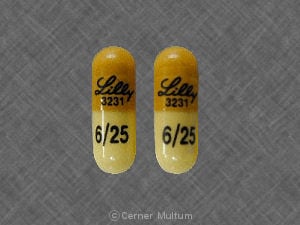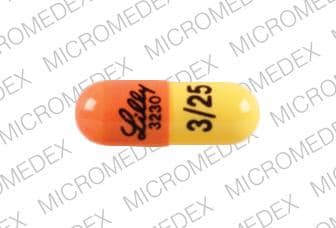What is Symbyax?
Symbyax is a prescription medicine used for:
- short-term treatment of episodes of depression that happen with Bipolar I Disorder in people age 10 or older.
- treatment of episodes of depression that do not respond to 2 other medicines, also called treatment resistant depression, in adults.
Symbyax contains two medicines, olanzapine and fluoxetine hydrochloride.
It is not known if Symbyax is safe and effective in children under the age of 10.
The symptoms of Bipolar I Disorder include alternating periods of depression and high or irritable mood, increased activity and restlessness, racing thoughts, talking fast, impulsive behavior, and a decreased need for sleep. With treatment, some of your symptoms of Bipolar I Disorder may improve.
The symptoms of treatment resistant depression include decreased mood, decreased interest, increased guilty feelings, decreased energy, decreased concentration, changes in appetite, and suicidal thoughts or behavior. With treatment, some of your symptoms of treatment resistant depression may improve.
If you do not think you are getting better, call your doctor.
What is the most important information I should know about Symbyax?
Symbyax may cause serious side effects, including:
- Suicidal thoughts or actions.
- Increased risk of death in elderly people who are confused, have memory loss and have lost touch with reality (dementia-related psychosis).
- High blood sugar (hyperglycemia).
- High fat levels in your blood (increased cholesterol and triglycerides), especially in children and adolescents age 10 to 17.
- Weight gain, especially in children and adolescents age 10 to 17.
These serious side effects are described below.
1. Suicidal thoughts or actions.
- Antidepressant medicines, depression and other serious mental illnesses, and suicidal thoughts or actions:
Talk to your, or your family member's, healthcare provider about:- all risks and benefits of treatment with antidepressant medicines.
- all treatment choices for depression or other serious mental illness.
- Antidepressant medicines may increase suicidal thoughts or actions in some children, teenagers, and young adults within the first few months of treatment.
- Depression and other serious mental illnesses are the most important causes of suicidal thoughts and actions. Some people may have a particularly high risk of having suicidal thoughts or actions. These include people who have (or have a family history of) bipolar illness (also called manic-depressive illness) or suicidal thoughts or actions.
- How can I watch for and try to prevent suicidal thoughts and actions in myself or a family member?
- Pay close attention to any changes, especially sudden changes, in mood, behaviors, thoughts, or feelings. This is very important when an antidepressant medicine is started or when the dose is changed.
- Call the healthcare provider right away to report new or sudden changes in mood, behavior, thoughts, or feelings.
- Keep all follow-up visits with the healthcare provider as scheduled. Call the healthcare provider between visits as needed, especially if you have concerns about symptoms.
Call a healthcare provider right away if you or your family member has any of the following symptoms, especially if they are new, worse, or worry you:
- thoughts about suicide or dying
- attempts to commit suicide
- new or worse depression
- new or worse anxiety
- feeling very agitated or restless
- panic attacks
- trouble sleeping (insomnia)
- new or worse irritability
- acting aggressive, being angry, or violent
- acting on dangerous impulses
- an extreme increase in activity and talking (mania)
- or other unusual changes in behavior or mood.
What else do I need to know about antidepressant medicines
- Never stop an antidepressant medicine without first talking to a healthcare provider. Stopping an antidepressant medicine suddenly can cause other symptoms.
- Antidepressants are medicines used to treat depression and other illnesses. It is important to discuss all the risks of treating depression and also the risks of not treating it. Patients and their families or other caregivers should discuss all treatment choices with the healthcare provider, not just the use of antidepressants.
- Antidepressant medicines have other side effects. Talk to the healthcare provider about the side effects of the medicine prescribed for you or your family member.
- Antidepressant medicines can interact with other medicines. Know all of the medicines that you or your family member takes. Keep a list of all medicines to show the healthcare provider. Do not start new medicines without first checking with your healthcare provider.
- Not all antidepressant medicines prescribed for children are FDA approved for use in children. Talk to your child's healthcare provider for more information.
2. Increased risk of death in elderly people who are confused, have memory loss and have lost touch with reality (dementia-related psychosis). Symbyax is not approved for treating psychosis in elderly people with dementia.
3. High blood sugar (hyperglycemia): High blood sugar can happen if you have diabetes already or if you have never had diabetes. High blood sugar could lead to:
- build up of acid in your blood due to ketones (ketoacidosis)
- coma
- death
Your doctor should do tests to check your blood sugar before you start taking Symbyax and during treatment. In people who do not have diabetes, sometimes high blood sugar goes away when Symbyax is stopped. People with diabetes and some people who did not have diabetes before taking Symbyax need to take medicine for high blood sugar even after they stop taking Symbyax.
If you have diabetes, follow your doctor's instructions about how often to check your blood sugar while taking Symbyax.
Call your doctor if you have any of these symptoms of high blood sugar (hyperglycemia) while taking Symbyax:
- feel very thirsty
- need to urinate more than usual
- feel very hungry
- feel weak or tired
- feel sick to your stomach
- feel confused, or your breath smells fruity.
4. High fat levels in your blood (increased cholesterol and triglycerides). High fat levels may happen in people treated with Symbyax, especially in children and adolescents (10 to 17 years old). You may not have any symptoms, so your doctor should do blood tests to check your cholesterol and triglyceride levels before you start taking Symbyax and during treatment.
5. Increase in weight (weight gain): Weight gain is common in people who take Symbyax. Children and adolescents (10 to 17 years old) who received Symbyax, were more likely to gain weight and to gain more weight than adults. Some people may gain a lot of weight while taking Symbyax, so you and your doctor should check your weight regularly. Talk to your doctor about ways to control weight gain, such as eating a healthy, balanced diet, and exercising
Who should not take Symbyax?
- Do not take Symbyax if you take a Monoamine Oxidase Inhibitor (MAOI). Ask your healthcare provider or pharmacist if you are not sure if you take an MAOI, including the antibiotic linezolid.
- Do not take an MAOI within 5 weeks of stopping Symbyax unless directed to do so by your physician.
- Do not start Symbyax if you stopped taking an MAOI in the last 2 weeks unless directed to do so by your physician.
People who take Symbyax close in time to an MAOI can have serious and life-threatening side effects, with symptoms including:
- high fever
- continued muscle spasms that you cannot control
- rigid muscles
- changes in heart rate and blood pressure that happen fast
- confusion
- unconsciousness.
- Do not take Symbyax if you take Mellaril (thioridazine). Do not take Mellaril within 5 weeks of stopping Symbyax. Mellaril can cause serious heart rhythm problems and you could die suddenly.
- Do not take Symbyax if you take the antipsychotic medicine pimozide (Orap). Do not take pimozide (Orap) within 5 weeks of stopping Symbyax.
What should I tell my healthcare provider before taking Symbyax?
Symbyax may not be right for you. Before starting Symbyax, tell your doctor about all your medical conditions, including if you have or had any of the following:
- heart problems
- seizures (convulsions)
- diabetes or high blood sugar levels (hyperglycemia)
- high cholesterol or triglyceride levels in your blood
- liver problems
- low or high blood pressure
- strokes or “mini-strokes” also called transient ischemic attacks (TIAs)
- bleeding problems
- Alzheimer's disease
- angle-closure glaucoma
- enlarged prostate in men
- bowel obstruction
- breast cancer
- are pregnant or plan to become pregnant. It is not known if Symbyax will harm your unborn baby.
- are breast-feeding or plan to breast-feed. Olanzapine and fluoxetine can pass into your breast milk and may harm your baby. You should not breast-feed while taking Symbyax. Talk to your doctor about the best way to feed your baby if you take Symbyax.
Before starting Symbyax, tell your doctor about all the medicines that you take, including
- Prescription and non-prescription medicines
- Vitamins, and herbal supplements
- Triptans used to treat migraine headache
- Medicines used to treat mood, anxiety, psychotic or thought disorders, including tricyclics, lithium, buspirone, SSRIs, SNRIs, MAOIs, or antipsychotics
- Tramadol and fentanyl
- Amphetamines
- Over-the-counter supplements such as tryptophan or St. John's Wort
- Electroconvulsive therapy (ECT)
Symbyax and some medicines may interact with each other and may not work as well, or cause possible serious side effects. Your doctor can tell you if it is safe to take Symbyax with your other medicines. Do not start or stop any medicine while taking Symbyax without talking to your doctor first.
If you take Symbyax, you should not take any other medicines that contain:
- olanzapine (the active ingredient in Zyprexa and Zyprexa Zydis) or
- fluoxetine hydrochloride (the active ingredient in Prozac, Prozac Weekly™, and Sarafem).
You could take too much medicine (overdose).
How should I take Symbyax?
- Take Symbyax exactly as prescribed. Your doctor may need to change (adjust) the dose of Symbyax until it is right for you.
- If you miss a dose of Symbyax, take the missed dose as soon as you remember. If it is almost time for the next dose, skip the missed dose and take your next dose at the regular time. Do not take two doses of Symbyax at the same time.
- To prevent serious side effects, do not stop taking Symbyax suddenly. If you need to stop taking SYMBYAX, your doctor can tell you how to safely stop taking it.
- If you take too much Symbyax, call your doctor or poison control center right away, or get emergency treatment.
- Symbyax can be taken with or without food.
- Symbyax is usually taken one time each day, in the evening.
- If you do not think you are getting better or have any concerns about your condition while taking Symbyax, call your doctor.
What should I avoid while taking Symbyax?
- Symbyax can cause sleepiness and may affect your ability to make decisions, think clearly, or react quickly. You should not drive, operate heavy machinery, or do other dangerous activities until you know how Symbyax affects you.
- Avoid drinking alcohol while taking Symbyax. Drinking alcohol while you take Symbyax may make you sleepier than if you take Symbyax alone.
What are the possible side effects of Symbyax?
Other possible serious risks:
- Increased risk of death and increased incidence of stroke or "mini-strokes" called transient ischemic attacks (TIAs) in elderly people with psychosis related to dementia (a brain disorder that lessens the ability to remember, think, and reason). Symbyax is not approved for these patients.
- Severe allergic reactions: Tell your doctor right away if you get red itchy welts (hives) or, a rash alone or with fever and joint pain, while taking Symbyax. Call your doctor right away if you become severely ill and have some or all of these symptoms:
- swelling of your face, eyes, or mouth
- trouble breathing
- Neuroleptic malignant syndrome (NMS): NMS is a rare but very serious condition that can happen in people who take antipsychotic medicines, including Symbyax. NMS can cause death and must be treated in a hospital. Call your doctor right away if you become severely ill and have some or all of these symptoms:
- high fever
- excessive sweating
- rigid muscles
- confusion
- changes in your breathing, heartbeat, and blood pressure
- Drug Reaction with Eosinophilia and Systemic Symptoms (DRESS): DRESS can occur. Features of DRESS may include rash, fever, swollen glands and other internal organ involvement such as liver, kidney, lung and heart. DRESS is sometimes fatal; therefore, tell your doctor immediately if you experience any of these signs.
- Tardive Dyskinesia: This condition causes body movements that keep happening and that you cannot control. These movements usually affect the face and tongue. Tardive dyskinesia may not go away, even if you stop taking Symbyax. It may also start after you stop taking Symbyax. Tell your doctor if you get any body movements that you cannot control.
- Serotonin Syndrome: This is a condition that can be life threatening. Call your doctor right away if you become severely ill and have some or all of these symptoms:
- agitation, hallucinations, coma or other changes in mental status
- coordination problems or muscle twitching (overactive reflexes)
- racing heartbeat, high or low blood pressure
- sweating or fever
- nausea, vomiting, and diarrhea
- muscle rigidity
- dizziness
- flushing
- tremor
- seizures
- Visual problems:
- eye pain
- changes in vision
- swelling or redness in or around the eye
- Abnormal bleeding: Tell your doctor if you notice any increased or unusual bruising or bleeding while taking Symbyax, especially if you take one of these medicines:
- the blood thinner warfarin (Coumadin, Jantoven)
- a non-steroidal anti-inflammatory drug (NSAID)
- aspirin
- Low salt (sodium) levels in the blood (hyponatremia): Call your doctor right away if you become severely ill and have some or all of these symptoms:
- headache
- feel weak
- confusion
- problems concentrating
- memory problems
- feel unsteady
- Changes in the electrical activity of your heart (QT prolongation and ventricular arrhythmia including Torsade de Pointes). This condition can be life threatening. The symptoms may include:
- fast, slow, or irregular heartbeat
- shortness of breath
- dizziness or fainting
- Decreased blood pressure when you change positions, with symptoms of dizziness, fast or slow heart beat, or fainting
- Difficulty swallowing
- Seizures
- Problems with control of body temperature: You could become very hot, for instance when you exercise a lot or stay in an area that is very hot. It is important for you to drink water to avoid dehydration. Call your doctor right away if you become severely ill and have some or all of these symptoms of dehydration:
- sweating too much or not at all
- dry mouth
- feeling very hot
- feeling thirsty
- not able to produce urine
Common possible side effects of Symbyax include: dry mouth, tiredness, sleeping for long period of time, increased appetite, swelling of your hands and feet, drowsiness, tremors (shakes), blurred vision.
Tell your doctor about any side effect that bothers you or that does not go away.
These are not all the possible side effects with Symbyax. For more information, ask your doctor or pharmacist.
Call your doctor for medical advice about side effects. You may report side effects to FDA at 1-800-FDA-1088.
Symbyax Images
General information about the safe and effective use of Symbyax
Medicines are sometimes prescribed for purposes other than those listed in a Medication Guide. Do not use Symbyax for a condition for which it was not prescribed. Do not give Symbyax to other people, even if they have the same condition. It may harm them.
This Medication Guide summarizes the most important information about Symbyax. If you would like more information, talk with your doctor. You can ask your doctor or pharmacist for information about Symbyax that was written for healthcare professionals. For more information about Symbyax call 1-800-Lilly-Rx (1-800-545-5979).
How should I store Symbyax?
- Store Symbyax at room temperature, between 59°F to 86°F (15°C to 30°C).
- Keep Symbyax away from light.
- Keep Symbyax dry and away from moisture. Keep the bottle closed tightly.
Keep Symbyax and all medicines out of the reach of children.
What are the ingredients in Symbyax?
Active ingredients: olanzapine and fluoxetine hydrochloride
Inactive ingredients: pregelatinized starch, gelatin, dimethicone, titanium dioxide, sodium lauryl sulfate, edible black ink, red iron oxide, yellow iron oxide, and/or black iron oxide.






